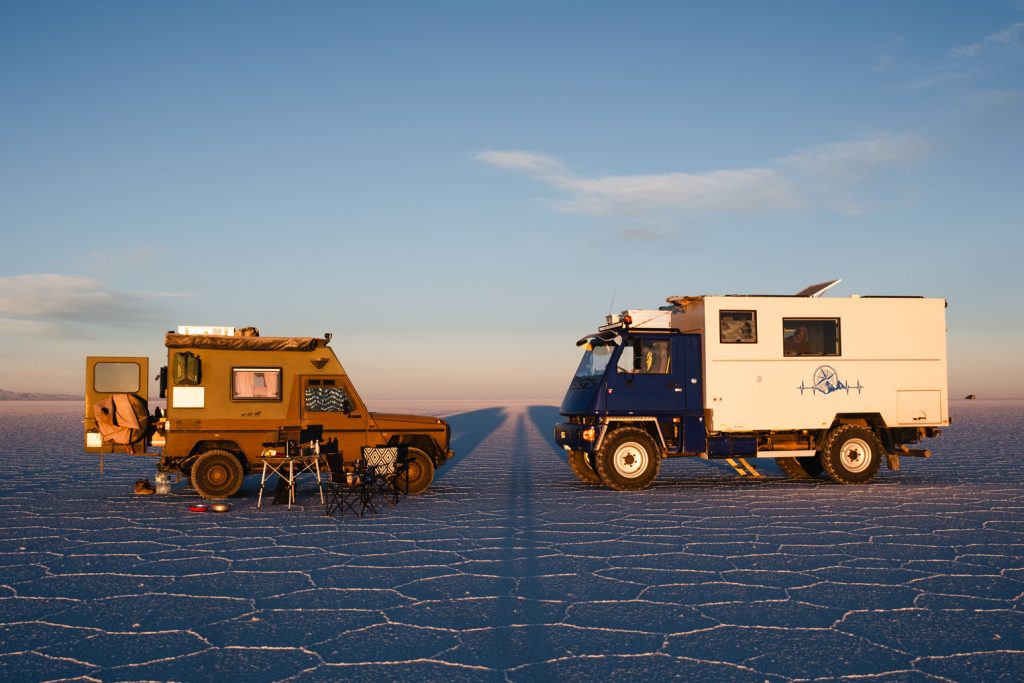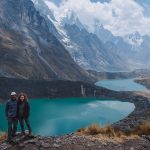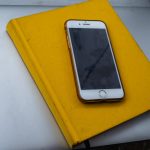Salar de Uyuni: The largest salt flat in the world and how to experience it
The Salar de Uyuni is one of Bolivia's main attractions. The largest salt flat in the world is likely on the bucket list of all travelers to Bolivia. We spent a total of three days on the salt flat, and for us, the days and nights on the Salar de Uyuni were an absolute highlight of our trip.
In this article, we share our travel report and tips for visiting the Salar de Uyuni.

Background and formation of the Salar
The Salar de Uyuni in Bolivia spans over 10,000 square kilometers, making it the largest salt flat in the world. This makes the salt flat twice the size of Sweden's largest lake, Vänern. Over 10,000 years ago, the salt crust was formed when a vast prehistoric lake dried up. Today, this snow-white desert in southwestern Bolivia, on the Altiplano high plateau, creates one of the most fascinating landscapes on Earth. At an elevation of 3,653 meters, the Salar de Uyuni not only offers breathtaking views but also unique photo opportunities.
Access to the Salar de Uyuni
From Uyuni, the closest access point to the Salar de Uyuni is in Colchani, about 22 kilometers north of the town of Uyuni. A paved road leads directly from Uyuni to Colchani. There, a turnoff to the left leads onto the salt flat. Most tour operators use this access point for their tours. Once on the salt flat, there are no fixed roads, but the tracks left by tour vehicles provide some orientation.
Sights: Dakar Monument, Isla Incahuasi, and more
Dakar Monument and Plaza de las Banderas

Once on the Salar, there is no real road anymore. However, since we are traveling during the dry season, you can still see vehicle tracks, especially at the beginning. The further you venture into the vastness of the Salar, the fewer tire tracks you see. We are using Maps.me for navigating on the Salar.
Von Colchani aus sind es nur 12 Kilometer bis zum berühmten Dakar Monument und der Plaza de las Banderas, einem Platz, der mit Flaggen aus aller Welt geschmückt ist. In dem kleinen Salzhaus findet man Toiletten und einige Sitzgelegenheiten. Zudem werden Souvenirs verkauft. Da wir uns in einem der Haupttouristenattraktionen Perus befinden, sind diese jedoch auch entsprechend teuer. Wir fahren stattdessen weiter auf dem Salar.
Isla Incahuasi: Cacti in the heart of the salt flat
About 75 kilometers from Colchani lies Isla Incahuasi, an impressive island in the middle of the Salar. Along with the salt flat itself, it is one of the main attractions of the Salar de Uyuni. This island is known for its giant cacti, some of which are up to 1,200 years old. The entire island appears surreal in the white surroundings. A small trail leads up to a viewpoint, offering a spectacular view over the vast salt flat. The entrance fee is 30 Bolivianos, around €4, and it is absolutely worth it. For us, the climb was no problem thanks to our acclimatization on the Lagunas Route, but we saw some other tourists visibly struggling with the thin air.
In addition to Isla Incahuasi, there are other islands in the Salar, but Incahuasi is the largest and the only one with tourist infrastructure, such as trails and toilets.
From Isla Incahuasi, we continue driving to Isla del Pescado, about 94 kilometers from Colchani. Here, we park the camper and plan to spend the night. Traveling with our own vehicle proves to be a real advantage, as the sunset on the Salar is simply magical and unforgettable.



Photo tips for the Salar de Uyuni – How to capture the perfect perspectives
The Salar de Uyuni is world-famous for its surreal photo opportunities, created by the vastness and the white surface. A photo shoot is almost a must for every visitor. Particularly popular are the perspective tricks, where objects and people are staged in amusing size ratios due to the lack of scale. The Lonely Planet even recommends bringing a small dinosaur toy for the photos – at the entrance to the Salar, you can even rent dinosaur figures. Instead, we use our Puch and various items from our camper. After a few attempts, we got the hang of it. The photos turn out best when the background is nothing but the endless white expanse of the Salar – this makes the effects most impressive.
Here are a few tips for taking great photos on the Salar:
- Perspective tricks: The Salar de Uyuni is perfect for optical illusions. Since there are no reference points in the surroundings, you can play with perspective and create creative photos. Place objects like toys, vehicles, or people at different distances to manipulate size proportions.
- Best time for photos: The time shortly after sunrise and before sunset offers the best light for photos. During sunrise and sunset, the colors on the horizon create beautiful contrasts with the white salt flat.
- Rainy season reflections: If you visit the Salar during the rainy season, you can capture the mesmerizing reflections. The thin layer of water on the salt crust reflects the sky on the ground. When there are no other objects visible in the background, it creates photos that appear like an endless mirror.
- Props: Many travelers use props like dinosaur toys, cups, hats, etc., to create funny photos – there are no limits to creativity!




With your own vehicle on the Salar de Uyuni – Tips for self-drivers
The Salar de Uyuni is an absolute highlight for self-drivers, but there are a few things to keep in mind. The experience of driving our own vehicle on this vast white expanse was simply indescribable for us. It's hard to put into words how surreal this environment feels.
Dry and rainy season: What to expect
In the dry season, which lasts from May to October, the Salar is firm and almost fully drivable. This time is ideal for self-drivers, as even larger vehicles like trucks can easily travel over the hard salt crust. The clear blue sky and the endless white surface offer perfect conditions for off-road adventures. However, you should always drive cautiously near the islands and the edges of the Salar, as the ground can still be muddy in these areas, even during the dry season. We met other overlanders who were traveling at the same time as us, got stuck, and couldn’t get out without help.
The rainy season from November to April often turns the Salar into a vast mirror surface, which provides spectacular photo opportunities. However, during this time, some parts of the Salar can be several centimeters under water, making driving dangerous. It’s especially important for self-drivers to check the conditions in advance, as the salt flat can have more muddy areas during the rainy season. Some sections are inaccessible to vehicles during this time, so it’s advisable to research the drivable routes beforehand. Since we weren’t traveling during the rainy season, we don’t have firsthand experience with this.


Vehicle maintenance after visiting the Salar de Uyuni – How to protect your car from salt damage
First and foremost, you should properly prepare your vehicle. The salt crust can take quite a toll on your car, and it’s highly recommended to thoroughly wash it after your visit to rinse off the salt and avoid damage. In Uyuni, there are several car wash stations that specialize in preparing vehicles for the drive on the Salar and washing them afterward. We had our Puch cleaned both before and after the drive on the Salar de Uyuni at Lavadero Maria Elena in Uyuni.
Before we drive onto the salt flat, the underbody is treated with used oil. This protects the chassis from the salt. After driving over the flat, the vehicle is thoroughly washed. We can highly recommend Lavadero Maria Elena in Uyuni; we received the most thorough car wash in all of South America here!
Practical tips for your visit to the Salar de Uyuni
- Suncream and sunglasses are a must. The reflection of sunlight on the white salt crust is extremely strong. During the day, you can't go without sunglasses!
- Warm clothes for the night, as temperatures can drop well below freezing.
- Water: Bring enough water. The high altitude can be exhausting, and there are not many supply options.

